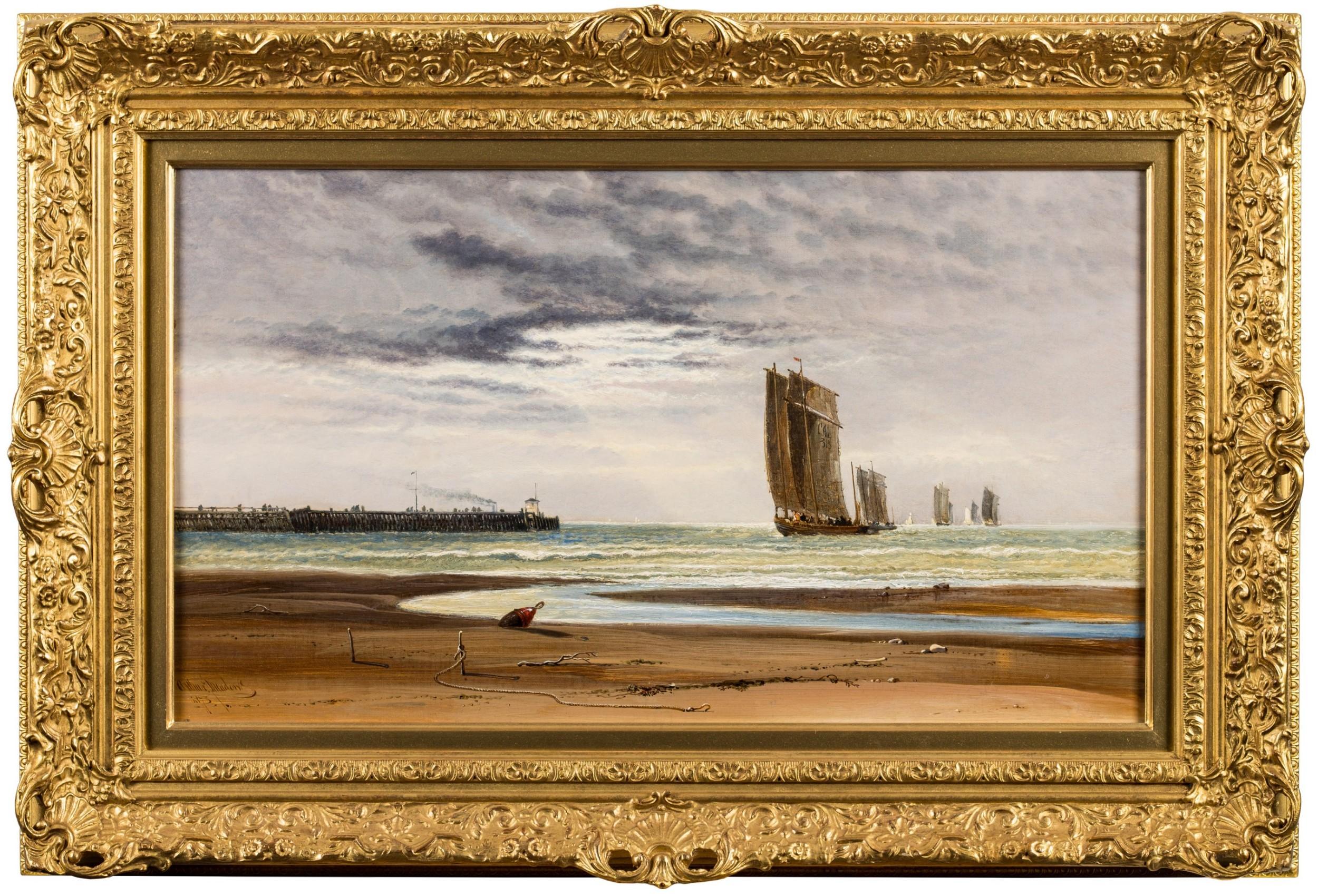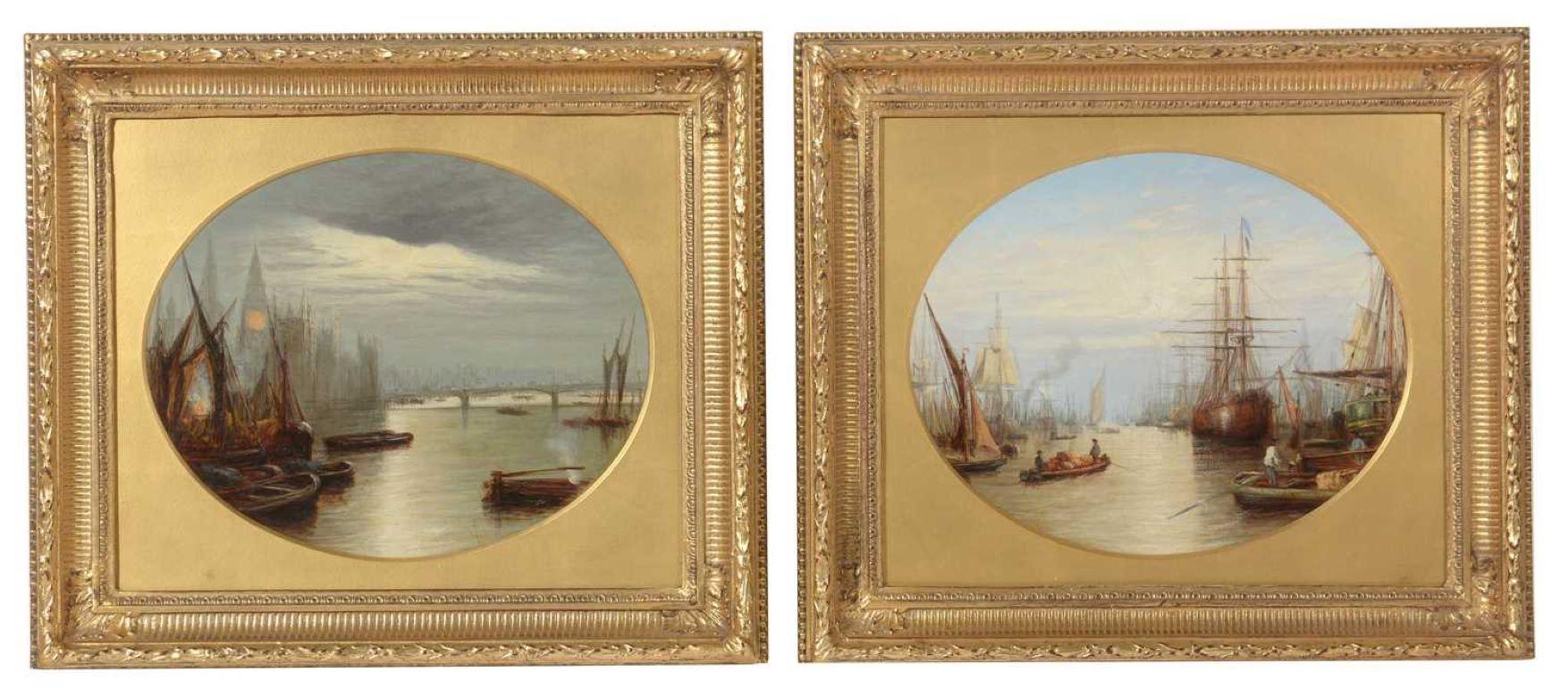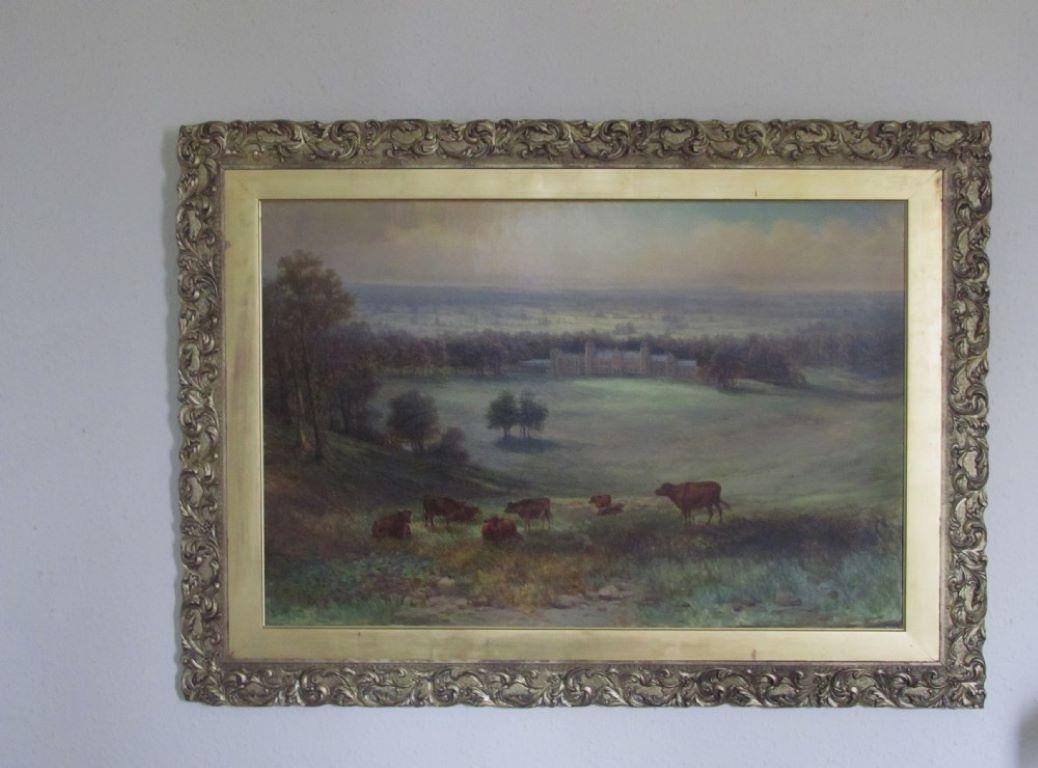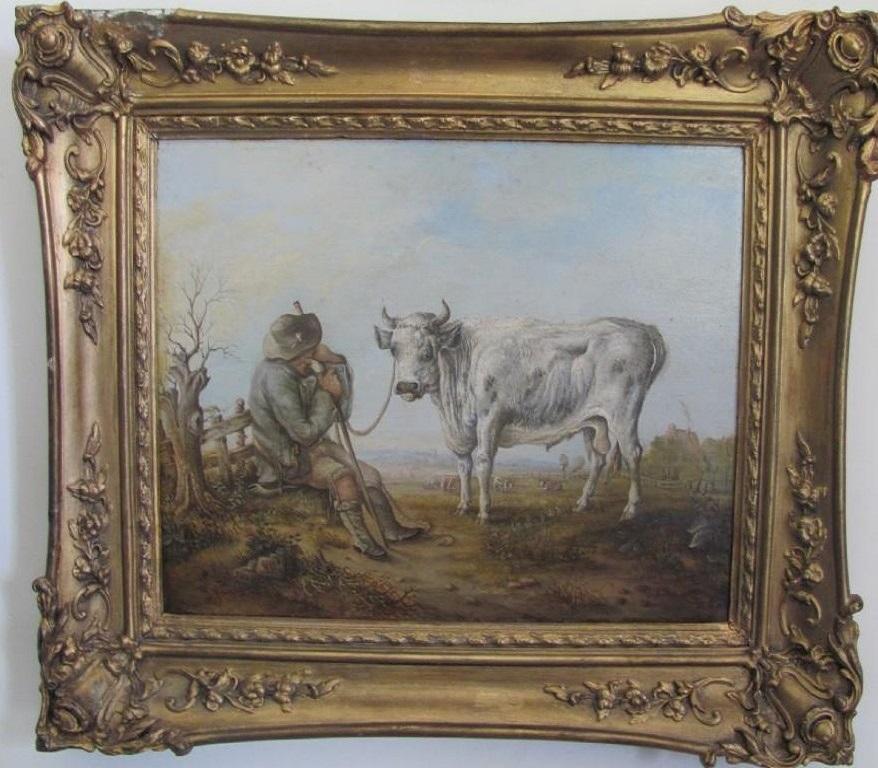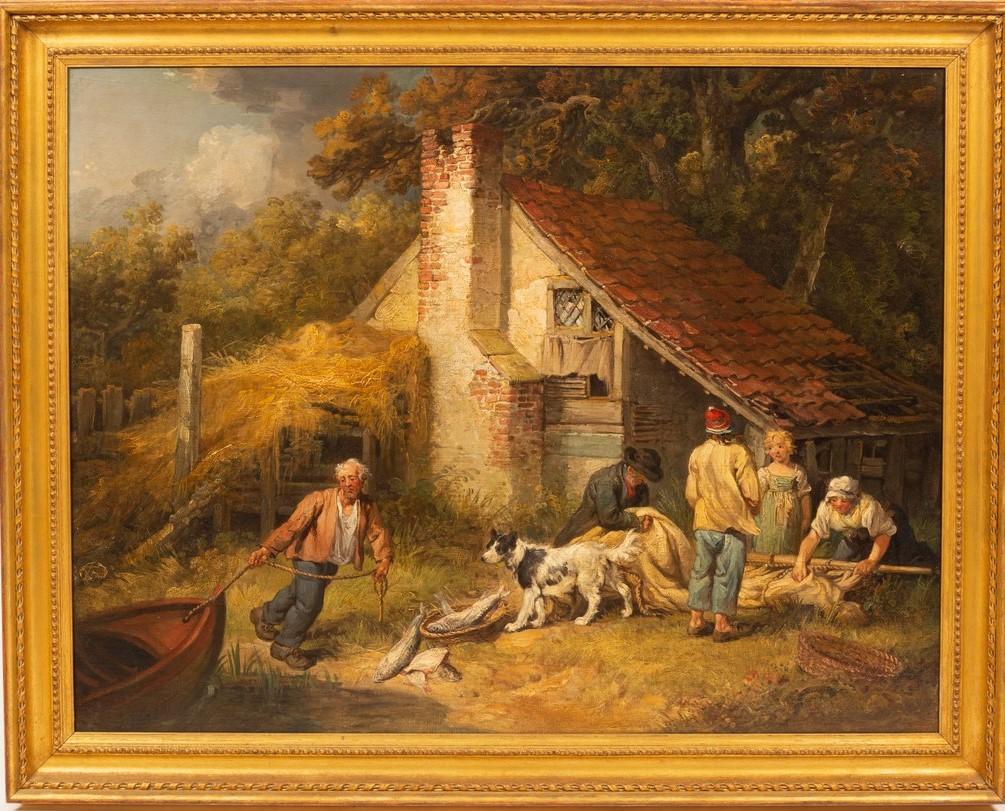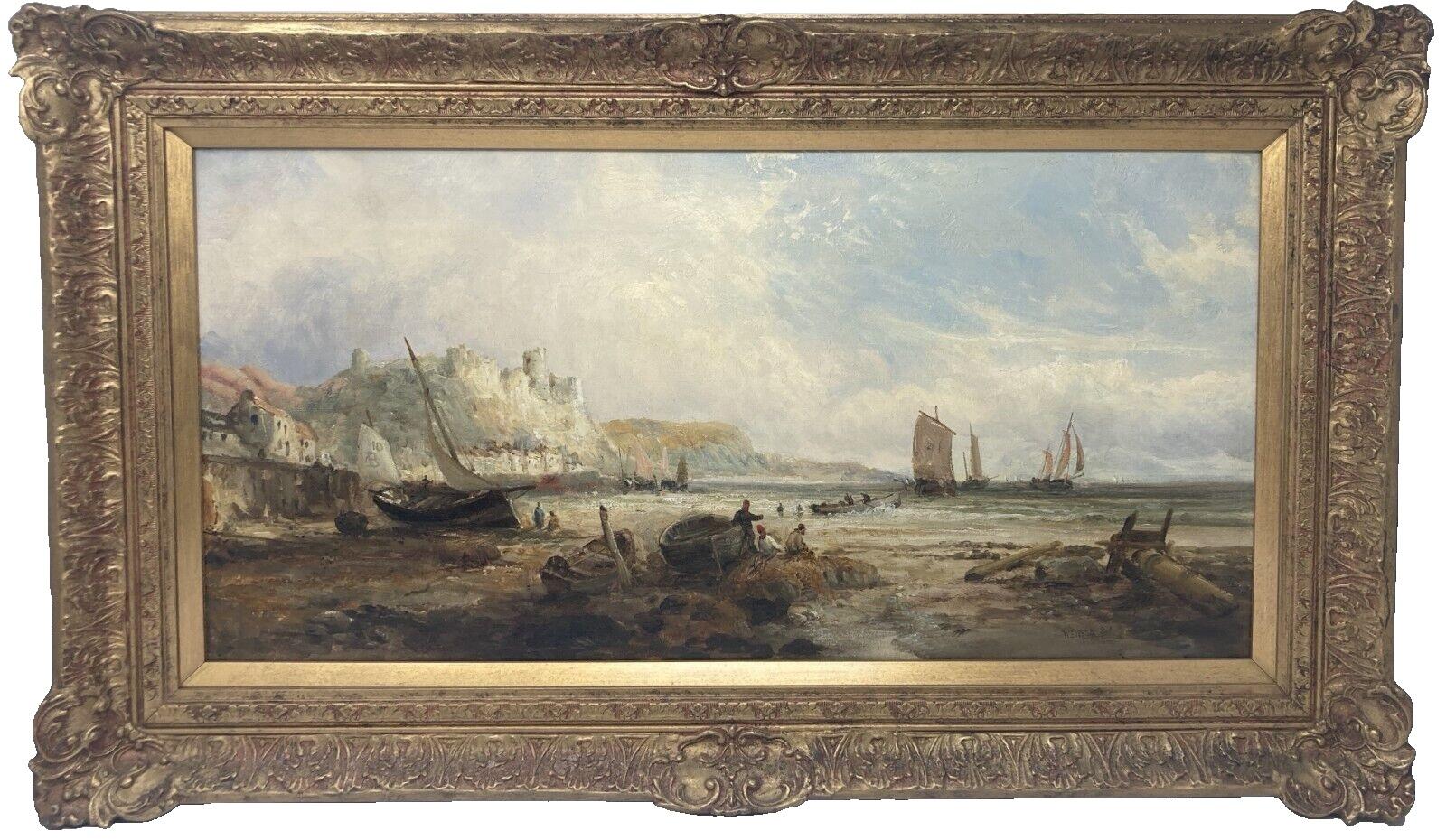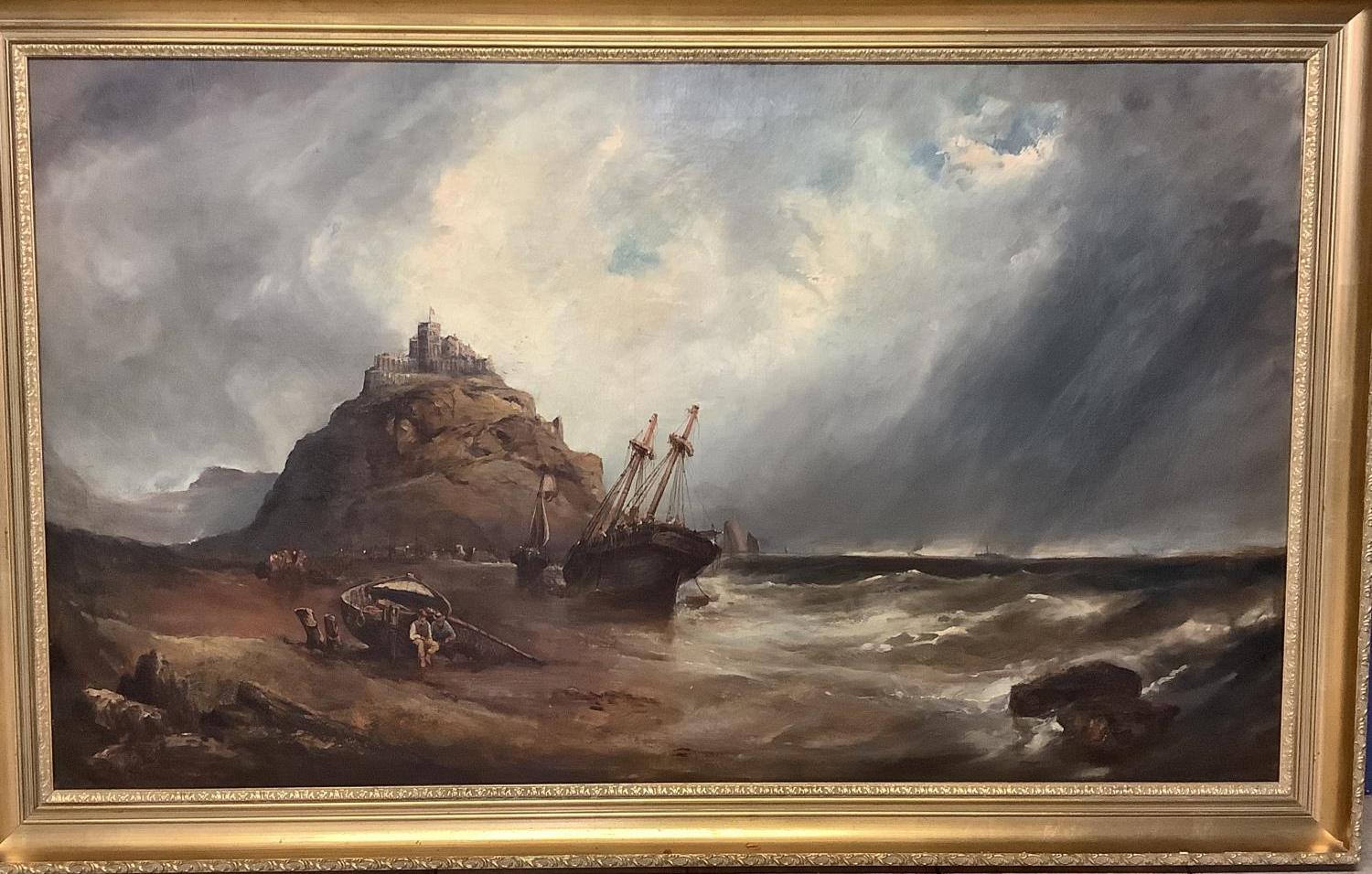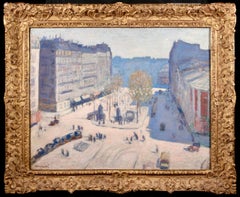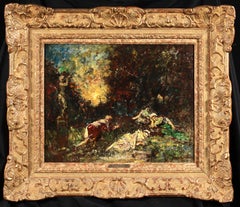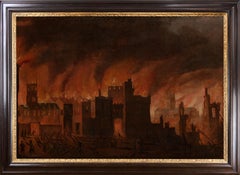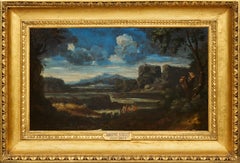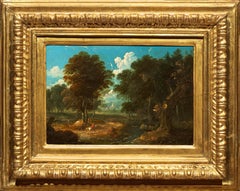GEORGE MORLAND R.A. - ORIGINAL OIL CANVAS - BOATS HEADING OUT ISLE OF WIGHT
View Similar Items
Want more images or videos?
Request additional images or videos from the seller
1 of 22
George MorlandGEORGE MORLAND R.A. - ORIGINAL OIL CANVAS - BOATS HEADING OUT ISLE OF WIGHT1790
1790
About the Item
- Creator:George Morland (1763 - 1804, English)
- Creation Year:1790
- Dimensions:Height: 27 in (68.58 cm)Width: 35 in (88.9 cm)Depth: 3 in (7.62 cm)
- Medium:
- Movement & Style:
- Period:
- Condition:
- Gallery Location:Marlow, GB
- Reference Number:1stDibs: LU41539824192
About the Seller
5.0
Platinum Seller
These expertly vetted sellers are 1stDibs' most experienced sellers and are rated highest by our customers.
Established in 2001
1stDibs seller since 2016
668 sales on 1stDibs
Typical response time: 3 hours
More From This SellerView All
- Jardin eclaire par la lune - Impressionist Oil, Night Landscape by Marie DuhemBy Marie DuhemLocated in Marlow, BuckinghamshireSigned and titled oil on canvas landscape circa 1910 by French Impressionist painter Marie Duhem. The work depicts a gated garden surrounded by bushes and trees and a tall tree in the centre. There are stars in the dark blue night's sky and the glow of the moon can be seen low behind the bare trees. Signature: Signed lower right/further signed and titled on original label Dimensions: Framed: 34"x29" Unframed: 26"x21" Provenance: The collection of the painter's family Marie Duhem, was born in Guemps on March 18, 1871 and died in Douai on July 9, 1918. Marie Duhem's parents ran a lace factory. From her childhood, she became familiar with the work of model designers. She becomes the student of the painter Adrien Demont...Category
Early 1900s Impressionist Landscape Paintings
MaterialsCanvas, Oil
- Boulevard De Clichy - Post Impressionist City Landscape Painting by Albert AndreBy Albert AndreLocated in Marlow, BuckinghamshireSigned and titled figures in cityscape oil on canvas circa 1920 by post impressionist painter Albert Andre. This stunning and good-sized work depicts a view of the Boulevard de Clichy, a famous street in the city of Paris, France on what appears to be a sunny but cool day. Signature: Signed lower left and titled & dated on original label verso Dimensions: Framed: 29"x35" Unframed: 22"x28" Provenance: New York, Durand-Ruel, Exhibition of Paintings by Albert André, 1 February -18 February, 1921 He came to Paris in 1889 as an industrial designer. At the age of 23 he enrolled at the studio of William Bouguereau at the Académie Julian, where he met Ranson, Louis Valtat and the young poet and dramatist Henry Bataille, who at the time was training as a painter. He illustrated L'étang de Berre by Charles Maurras and Les Petites Alliées by Claude Farrère. He produced cartoons for tapestries...Category
1920s Post-Impressionist Landscape Paintings
MaterialsCanvas, Oil
- Picking Violets - Impressionist Oil, Figures in Landscape by Adolphe MonticelliLocated in Marlow, BuckinghamshireSigned oil on panel figures in landscape circa 1875 by French painter Adolphe Joseph Thomas Monticelli. The work depicts young ladies on a grassy bank - some are lying down and resting and others are picking violets. Signature: Signed lower right Dimensions: Framed: 24"x28" Unframed: 15"x19" Provenance: Galerie Marc Stammegna - Marseille - Exposition Adolphe Monticelli (18th September - 4th October 2008). This work is included in the Catalogue Raisonne of Adolphe Monticelli Tome I illustration 197, P. 106. A certificate from Marc Stammegna accompanies the painting Monticelli entered the Paris studio of Paul Delaroche at the age of 22. His parents initially favoured a career as a pharmacist, but were soon convinced of his artistic vocation, thanks more to their son's complete lack of enthusiasm for any other activity than to evidence of outstanding talent on his part. Adolphe was a relatively undistinguished student during his three years at the municipal school of drawing in Marseilles; his true inspiration was the Louvre, where he spent long hours copying works by Rembrandt, Veronese and Giorgione, and where he met Delacroix, whom he admired throughout his life. Museum and Gallery Holdings Aix-en-Provence: Ladies in a Park; Landscape; Head of a Ruffianly Soldier Aix-en-Provence (Mus. Granet): Park Scene (oil on canvas) Algiers: Woman with a Dog Allauch (Church of St-Sebastien): Let's Go for Heaven Amsterdam (Rijksmus.): Jesus among the Little Children; Sunlit Promontory; At the Altar; Woman in a Tailored Jacket; Outdoor Gathering of Ladies and Gentlemen; Elegant Company in a Park; Landscape Amsterdam (Stedelijk Mus.): Resting in a Forest Antwerp: Figure in a Park; The Port at Marseilles Baltimore: Track through the Woods; Allegory (oil sketch); Allegory; Spring Morning; Allegory; Sunset; Portrait of Monticelli Boston: Scene from Don Quixote; Scene on a Terrace; Landscape Bowes: Landscape Brussels: Autumn Bucharest (Muz. National de Arta al României): Scene in a Park; Portrait of a Woman Buffalo: Portrait of Madame Rosenthal (attributed); Cardiff: Capers Dijon: Departure of the Hunt Edinburgh (Nat. Gal. of Scotland): A Gypsy Encampment (oil/panel); The Fête (oil/panel); The Garden of Love (oil/panel); A Woodland Fête (oil/panel); A Garden Fête (oil?/panel); In the Grotto (oil/panel) Frankfurt am Main: painting; Scene in a Park Glasgow: Adoration of the Magi; A Garden Party; A Nuptial Procession Grasse: Scene in a Park Ixelles: Seascape Lille: Scene from the Decameron; Landscape London (NG): The Hayfield (1860-1880, oil/wood, on loan to the Hugh Lane Municipal Gallery of Modern Art, Dublin, since 1979); 12 paintings from Harry Wearne's collection Lyons: Portrait of Mme René; Scene in a Park; Bathing-party Manchester (City AG): A Woodland Glade; Ladies on a Terrace Marseilles (École des Beaux-Arts): Nude Marseilles (MBA): Women with Swans; Waterfowl; Portrait of Mme Pascal; Turks at the Mosque Marseilles (Mus. Cantini): Large Scene with Figures; Group of Figures with Mephistopheles; Riders and Figures; Provençal Landscape; Autumn Landscape (two works); Portrait of a child; Portrait of a Man; Portrait of a Woman; Portrait of M. Kahn Marseilles (Mus. du Vieux Marseille): Portrait of M. Vincent Torcat Marseilles (Mus. Grobet-Labadié): Bouquet of Flowers; Travelling Acrobats; Festive Scene in Spain; Faust and Margarete; Sketch; Monsoon; Landscape with Figures; Two Female Nudes; Two Cupids Milan: Adoration of the Magi Minneapolis (IA): Garden Scene (Scène de parc) (1868, oil on canvas) Montreal: Garden Party; An Intimate Gathering; Country Party; Dancing in a Garden; Donkey and Cart Moscow (Pushkin MFA): Landscape Mulhouse: Preparing for the Ball; Parrot New York: Ladies of Quality; Festive Scene New York (Metropolitan Mus. of Art): The Court of the Princess (La Cour de la Princesse) Paris (Louvre): Bathers; Strolling at Twilight; Serenade; Still-life; Gathering in a Park; Portrait of Mme Teissier; Women in a Glade Paris (Mus. des Arts décoratifs): Women in a Glade; Scene in a Park Paris (Mus. du Petit Palais): Gathering in a Park under the Valois Philadelphia (MA, Johnson Collection): Masquerade; Nymphs Bathing...Category
Late 19th Century Impressionist Figurative Paintings
MaterialsPanel, Oil
- Bergues - Impressionist Oil, Figures in Landscape by Henri DuhemBy Henri DuhemLocated in Marlow, BuckinghamshireSigned and dated figures in landscape oil on panel by French impressionist painter Henri Duhem. The work depicts a view of a mother and child walking along a path in a French village in Bergues, Northern France. The buildings of the village can be seen and a church just behind them. Thick cloud envelopes the blue sky. Signature: Signed lower right and dated 1914 and titled verso Dimensions: Unframed: 5.5"x7" This painting is not currently framed but a suitable frame can be sourced if required. Provenance: The artist's estate Descendant of an old Flemish family, Henri Duhem was born in Douai on April 7, 1860. He worked as a lawyer at the Bar of the Court of Douai from 1883, he practiced at the same time his passion for drawing and watercolor. In 1887, he enrolled in Henri Harpignies' drawing course in Paris and, at the same time, befriended the painter Émile Breton...Category
1910s Impressionist Landscape Paintings
MaterialsOil, Panel
- Fishing at Sunset - Impressionist Oil, Figures in Landscape by Henri DuhemBy Henri DuhemLocated in Marlow, BuckinghamshireSigned and dated impressionist oil on panel figures in landscape by French painter Henri Duhem. The work depicts a man fishing in a river as the moon rises over a cottage in the background. Signature: Signed lower left and dated 1911 verso Dimensions: Framed: 15.5"x19" Unframed: 9.5"x13" Proveance: The artist's estate Descendant of an old Flemish family, Henri Duhem was born in Douai on April 7, 1860. He worked as a lawyer at the Bar of the Court of Douai from 1883, he practiced at the same time his passion for drawing and watercolor. In 1887, he enrolled in Henri Harpignies' drawing course in Paris and, at the same time, befriended the painter Émile Breton...Category
1910s Impressionist Landscape Paintings
MaterialsOil, Panel
- Fishing on a River - Impressionist Oil, Boat on River Landscape by Louis JapyBy Louis Aimé JapyLocated in Marlow, BuckinghamshireSigned and dated riverscape oil on canvas by French impressionist painter Louis Aime Japy. The work depicts two fisherman in a small punt in a river at sunset. The clouds in the sky ...Category
Late 19th Century Impressionist Landscape Paintings
MaterialsOil, Canvas
You May Also Like
- Early oil depicting the Great Fire of LondonLocated in London, GBThe Great Fire of London in September 1666 was one of the greatest disasters in the city’s history. The City, with its wooden houses crowded together in narrow streets, was a natural fire risk, and predictions that London would burn down became a shocking reality. The fire began in a bakery in Pudding Lane, an area near the Thames teeming with warehouses and shops full of flammable materials, such as timber, oil, coal, pitch and turpentine. Inevitably the fire spread rapidly from this area into the City. Our painting depicts the impact of the fire on those who were caught in it and creates a very dramatic impression of what the fire was like. Closer inspection reveals a scene of chaos and panic with people running out of the gates. It shows Cripplegate in the north of the City, with St Giles without Cripplegate to its left, in flames (on the site of the present day Barbican). The painting probably represents the fire on the night of Tuesday 4 September, when four-fifths of the City was burning at once, including St Paul's Cathedral. Old St Paul’s can be seen to the right of the canvas, the medieval church with its thick stone walls, was considered a place of safety, but the building was covered in wooden scaffolding as it was in the midst of being restored by the then little known architect, Christopher Wren and caught fire. Our painting seems to depict a specific moment on the Tuesday night when the lead on St Paul’s caught fire and, as the diarist John Evelyn described: ‘the stones of Paul’s flew like grenades, the melting lead running down the streets in a stream and the very pavements glowing with the firey redness, so as no horse, nor man, was able to tread on them.’ Although the loss of life was minimal, some accounts record only sixteen perished, the magnitude of the property loss was shocking – some four hundred and thirty acres, about eighty per cent of the City proper was destroyed, including over thirteen thousand houses, eighty-nine churches, and fifty-two Guild Halls. Thousands were homeless and financially ruined. The Great Fire, and the subsequent fire of 1676, which destroyed over six hundred houses south of the Thames, changed the appearance of London forever. The one constructive outcome of the Great Fire was that the plague, which had devastated the population of London since 1665, diminished greatly, due to the mass death of the plague-carrying rats in the blaze. The fire was widely reported in eyewitness accounts, newspapers, letters and diaries. Samuel Pepys recorded climbing the steeple of Barking Church from which he viewed the destroyed City: ‘the saddest sight of desolation that I ever saw.’ There was an official enquiry into the causes of the fire, petitions to the King and Lord Mayor to rebuild, new legislation and building Acts. Naturally, the fire became a dramatic and extremely popular subject for painters and engravers. A group of works relatively closely related to the present picture have been traditionally ascribed to Jan Griffier...Category
17th Century Old Masters Landscape Paintings
MaterialsOil, Canvas
- Italian Landscape with Jack Players, a painting by Gaspard Dughet (1615 - 1675)By Gaspard DughetLocated in PARIS, FRHere Gaspard Dughet offers us an idyllic vision of the Roman countryside. The stages follow one another in a perfectly structured composition, revealing here a lake, there travellers walking along, gradually leading our eye to the blue horizon. But behind its classical composition, this landscape is particularly interesting because of three anthropomorphic details that the artist has hidden, opening the way to a radically different interpretation... 1. Gaspard Dughet, a landscape artist in the light of Poussin Gaspard Dughet was born on June 4th, 1615 in Rome where his father, of French origin, was a pastry cook. He was probably named Gaspard in honour of his godfather Baron Gaspard de Morant, who was, or may have been, his father's employer. His older sister Jeanne married the painter Nicolas Poussin (1594 - 1655) on September 1st, 1630. The young Gaspard was apprenticed with his brother-in-law at the beginning of 1631, which led his entourage to name him Gaspard Poussin. The first preserved works of the painter date from the years 1633-1634 and were painted in Poussin’s studio. Around 1635, Gaspard Dughet became emancipated and began to frequent the Bamboccianti circle. In 1636, he became friends with the painter Jean Miel (1599 - 1656), but also with Pier Francesco Mola (1612 - 1666) and Pietro da Cortona (1596 - 1669). This was also the time of his first trips throughout Italy. The painter, although of French origin, appears never to have visited France. In 1646 he settled permanently in Rome. A recognized painter with a solid book of orders, he remained faithful to landscape painting throughout his life, alternating between cabinet paintings and large decorative commissions, using both oil and fresco. Nailed to his bed by rheumatic fever at the age of 58, he died on May 25, 1675. 2. Discovering an idealized landscape Beyond a relatively dark foreground that takes us into the landscape, we discover a vast bluish horizon: a plateau surrounded by deep ravines advances to the right, overhanging an expanse of water that sparkles below. A road winds through a mountainous mass as if leading us to the fortress that crowns it; another town appears in the distance at the foot of three conical mountains. The composition is rigorous, mineral, and structured by geometric volumes. The various stages in the landscape lead one to the next attracting the eye towards the horizon located in the middle of the canvas. The general impression is that of a welcoming and serene nature. In many places the paint layer has shrunk, or become transparent, revealing the dark red preparation with which the canvas was covered and accentuating the contrasts. Human presence is limited to three jack players, leaning against a mound in the foreground. Their long garments, which may evoke Roman togas, contribute to the timelessness of the scene. Close examination of the canvas reveals two other travellers on the path winding between the rocks. Made tiny by the distance, their introduction in the middle register, typical of Dughet's art, lengthens the perspective. While it is difficult to date the work of a painter who devoted his entire life to the representation of landscapes, it is certain that this painting is a work from his later years. The trees that occupied the foreground of his youthful compositions have been relegated to the sides, a stretch of water separates us from the arid mountains counterbalanced by two trees represented on the opposite bank. The introduction of this stretch of water in the middle of the landscape betrays the influence of the Bolognese and in particular of the Dominiquin (1581 - 1641) A number of similarities with a drawing in the British Museum might suggest a date around 1656-1657, since, according to Marie-Nicole Boisclair , it has been compared with the Prado's Landscape with the Repentant Magdalene, painted at that period. 3. Three amazing anthropomorphic details While some late Renaissance landscapes offer a radical double reading, allowing one to see both a face or a human body behind the representation of a landscape, it seems interesting to us to hypothesize that Gaspard Dughet had fun here by slipping in a few details that, taken in isolation, evoke human or animal figures. We will give three examples, looking closely at a cloud, the trunk of a broken tree and the top of a cliff. The main cloud could thus evoke a Christ-like face or that of an antique god...Category
1650s Old Masters Landscape Paintings
MaterialsOil
- Stag Hunting in the Vicinity of Nuremberg by a German Artist Peter von BemmelLocated in PARIS, FRThis small landscape shows a hunting scene: two riders are chasing a stag with their dogs at the edge of a forest. Signed by Peter von Bemmel, it is typical of the production of this...Category
1720s Old Masters Landscape Paintings
MaterialsCopper
- River Landscape with Shepherds and Architecture, a painting by Jan van BunnikBy Jan van BunnikLocated in PARIS, FRThis painting has been the subject of a study by the art historian Fabrizio Dassie (available on request), confirming its inclusion in Jan van Bunnik’s corpus. In this painting, Ja...Category
Late 17th Century Old Masters Landscape Paintings
MaterialsCopper
- Arthur Joseph Meadows 19th Century Seascape Off CalaisBy Arthur Joseph MeadowsLocated in York, GBA very fine painting by the renowned seascape painter Arthur Joseph Meadows,Off Calais; fishing fleet returning at low tide. Housed in an antique style gilt frame the size overall is...Category
19th Century Old Masters Landscape Paintings
MaterialsOil
$6,346 Sale Price37% OffFree Shipping - 19th century oil, view London, the Thames, houses parliament, Francis MaltinoLocated in York, GBA fine pair of oil paintings, oil on board depicting views of the Thames one showing houses of parliament the other barges in busy shipping lane. Framed and Glazed the size being 26 ...Category
19th Century Old Masters Landscape Paintings
MaterialsOil
Recently Viewed
View AllMore Ways To Browse
John M Smith
Mid Century Cowboy Art
Antique Oil Paintings Of Seascapes
Painting Boats Picture
Covered Bridge Paintings
C Hart
Vintage Lake Board
Sea Swim
Walnut Creek
J Martin Painting
Old Walker Painting
Pyramid Drawing
Cornwall Uk
Carmel By The Sea Painting
Richard Ford
19th Century Paris Street Scene
Fin De Siecles
Ducks Oil Paint




